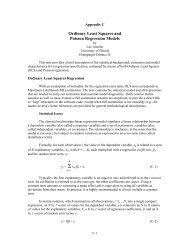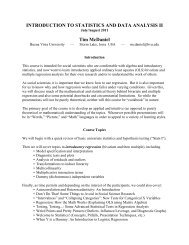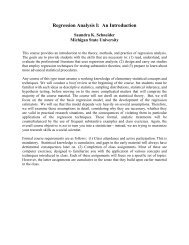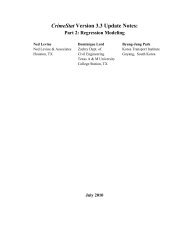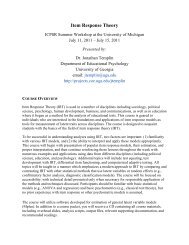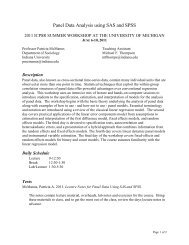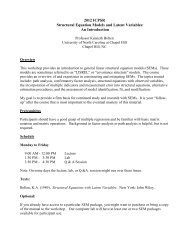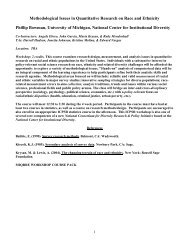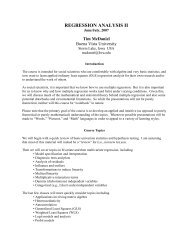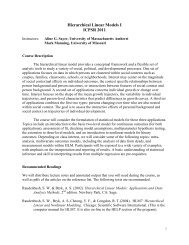Introduction to Spatial Regression Analysis Paul R. Voss and ... - icpsr
Introduction to Spatial Regression Analysis Paul R. Voss and ... - icpsr
Introduction to Spatial Regression Analysis Paul R. Voss and ... - icpsr
Create successful ePaper yourself
Turn your PDF publications into a flip-book with our unique Google optimized e-Paper software.
<strong>Introduction</strong> <strong>to</strong> <strong>Spatial</strong> <strong>Regression</strong> <strong>Analysis</strong><br />
<strong>Paul</strong> R. <strong>Voss</strong> 1 <strong>and</strong> Katherine Curtis 2<br />
1<br />
University of North Carolina at Chapel Hill<br />
2<br />
University of Wisconsin-Madison<br />
1<br />
Odum Institute for Research in Social Science<br />
2 Department of Rural Sociology<br />
Manning Hall, CB #3355<br />
1450 Linden Drive<br />
University of North Carolina at Chapel Hill University of Wisconsin-Madison<br />
Chapel Hill, NC 27599 Madison WI 53706<br />
voss@ssc.wisc.edu<br />
kcurtis@ssc.wisc.edu<br />
Objectives<br />
The goal of this five-day course is <strong>to</strong> provide an overview of applied spatial regression analysis<br />
(spatial econometrics) that will enable participants <strong>to</strong> effectively incorporate these <strong>to</strong>ols in<strong>to</strong> their<br />
own empirical research. The course will introduce the broader field of spatial data analysis <strong>and</strong><br />
the range of issues that generally must be dealt with when analyzing georeferenced data on a<br />
lattice. Census-type data are among the most commonly encountered data that conform <strong>to</strong> this<br />
description, although the course acknowledges the wider range of data appropriate for spatial<br />
regression analysis. In general, this is NOT a course where significant attention can be given <strong>to</strong><br />
spatial analyses involving so-called geostatistical data or point pattern data.<br />
Course Materials <strong>and</strong> Organization<br />
The course will convene each day from 9:00 a.m. until approximately 4:30 p.m., except for the<br />
last day (Friday), when the course likely will wind down earlier <strong>to</strong> enable participants who must<br />
meet Friday evening flights <strong>to</strong> do so. The course is organized in<strong>to</strong> a format that includes<br />
morning lectures (theoretical <strong>and</strong> conceptual underpinnings) <strong>and</strong> afternoon computing lab<br />
sessions (h<strong>and</strong>s-on applications). We will attempt <strong>to</strong> set aside the last half hour or more of each<br />
day for group discussion of the <strong>to</strong>pics introduced that day. Course materials are organized such<br />
that the readings supplement <strong>and</strong> provide greater detail on the <strong>to</strong>pics covered in the classroom.<br />
Many more <strong>to</strong>pics are introduced in the course lectures (assisted by PowerPoint) than can<br />
reasonably be absorbed in five intensive days, so the readings provide a point of return for<br />
review <strong>and</strong> deeper underst<strong>and</strong>ing of the <strong>to</strong>pics covered, as well as a source of references for<br />
further reading. The lab exercises are guided by written, step-by-step tu<strong>to</strong>rial instructions so that<br />
they can be repeated (<strong>and</strong> more fully absorbed) at a later time. All recommended readings <strong>and</strong><br />
lab exercises are available on-line.<br />
Software<br />
The course will use primarily the spatial analysis package GeoDa TM <strong>and</strong> the open source<br />
programming language R.
OUTLINE OF COURSE<br />
Day 1 Morning:<br />
1. Welcome <strong>and</strong> introductions<br />
2. Review of objectives <strong>and</strong> overview of week<br />
3. Goal <strong>and</strong> overview for Day 1<br />
4. Motivational example<br />
5. Underst<strong>and</strong>ing spatial data<br />
a. Overview of spatial data <strong>and</strong> spatial data analysis<br />
b. <strong>Spatial</strong> analysis vs. spatial data analysis<br />
c Classes of problems in spatial data analysis<br />
d. <strong>Spatial</strong> vs. non-spatial data analysis<br />
5. Why spatial is special<br />
a. Characteristics of spatial data<br />
b. Problems often caused by spatial data<br />
6. Review OLS estimation<br />
a. Assumptions of the classical linear regression model<br />
b. Consequences of violation of the assumptions<br />
7. The importance of explora<strong>to</strong>ry data analysis (EDA) <strong>and</strong> explora<strong>to</strong>ry spatial data<br />
analysis (ESDA)<br />
8. Orientation <strong>to</strong> afternoon lab: <strong>Introduction</strong> <strong>to</strong> shapefiles (attribute data <strong>and</strong> digital map<br />
married up) <strong>and</strong> elementary ESDA using GeoDa. TM Orientation <strong>to</strong> univariate EDA<br />
using R<br />
Day 1 Afternoon:<br />
1. Constructing/finding a shapefile<br />
2. <strong>Introduction</strong> <strong>to</strong> “our” shapefile; your task: Begin thinking now about hypotheses,<br />
models, <strong>and</strong> analyses<br />
3. Simple mapping operations using ArcGIS TM<br />
4. Reading a shapefile in<strong>to</strong> GeoDa TM<br />
5. Simple mapping operations using GeoDa TM<br />
6. Univariate EDA using R.<br />
Day 1 Readings:<br />
1. Anselin, Luc. 1989. “What is Special About <strong>Spatial</strong> Data? Alternative<br />
Perspectives on <strong>Spatial</strong> Data <strong>Analysis</strong>.” NCGIA Technical Paper 89-4.<br />
2. Ward, Michael D., <strong>and</strong> Kristian Skrede Gleditsch. 2008. <strong>Spatial</strong> <strong>Regression</strong><br />
Models. Quantitative Applications in the Social Sciences, No. 155. Thous<strong>and</strong><br />
Oaks, CA: Sage. Chapter 1. [This small book may be found as a downloadable<br />
PDF at: http://faculty.washing<strong>to</strong>n.edu/mdw/ ]<br />
3. Goodchild, Michael F., Luc Anselin, Richard P. Applebaum, <strong>and</strong> Barbara Herr<br />
Harthorn. 2000. “Toward <strong>Spatial</strong>ly Integrated Social Science.” International<br />
Regional Science Review 23:139-159.
4. Loftin, Colin <strong>and</strong> Sally K. Ward. 1983. “A <strong>Spatial</strong> Au<strong>to</strong>correlation Model of the<br />
Effects of Population Density on Fertility.” American Sociological Review,<br />
48(1):121-128.<br />
5. Galle, Omer R., Walter R. Gove, J. Miller McPherson. 1972. “Population Density<br />
<strong>and</strong> Pathology: What Are the Relations for Man?” Science (new series) 176:23-30<br />
Day 2 Morning:<br />
1. Q&A from readings or 1 st day lecture or lab<br />
2. Goal for Day 2: ESDA & spatial au<strong>to</strong>correlation<br />
3. Data exploration:<br />
a. Distribution aspects of dependent variable<br />
b. QQ Plots<br />
c. Linearity between dependent variable <strong>and</strong> independent variables<br />
d. Variable transformations; Box-Cox transformations<br />
4. Global spatial au<strong>to</strong>correlation & weights matrices<br />
a. What it is<br />
b. How it arises; <strong>Spatial</strong> processes<br />
i. <strong>Spatial</strong> heterogeneity<br />
ii. <strong>Spatial</strong> dependence<br />
c. Consequences of spatial au<strong>to</strong>correlation<br />
d. How <strong>to</strong> measure it<br />
i. Weights Matrices<br />
ii.<br />
Global measures of spatial au<strong>to</strong>correlation<br />
a. Global Moran statistic<br />
b. Global Geary statistic<br />
c. Problems with global measures<br />
5. Local measures of spatial au<strong>to</strong>correlation<br />
a. Local Moran<br />
b. Moran scatterplot<br />
c. LISA mapping<br />
7. Orientation <strong>to</strong> afternoon lab: ESDA <strong>and</strong> spatial au<strong>to</strong>correlation with GeoDa TM <strong>and</strong><br />
similar work in R.<br />
Day 2 Afternoon:<br />
1. <strong>Introduction</strong> <strong>to</strong> ESDA<br />
2. ESDA with GeoDa TM <strong>and</strong> R<br />
3. Creating <strong>and</strong> comparing weights matrices<br />
4. Global spatial au<strong>to</strong>correlation in GeoDa TM <strong>and</strong> R<br />
5. Local spatial au<strong>to</strong>correlation in GeoDa TM <strong>and</strong> R<br />
Day 2 Readings:<br />
1. Anselin, Luc. 1996. “The Moran Scatterplot as an ESDA Tool <strong>to</strong> Assess Local<br />
Instability in <strong>Spatial</strong> Association.” Pp. 111-125 in Fischer, Manfred, Henk J.
Scholten, <strong>and</strong> David Unwin (eds.) <strong>Spatial</strong> Analytical Perspectives on GIS: GISDATA<br />
4 (London: Taylor & Francis).<br />
2. Anselin, Luc. 1995. “Local Indica<strong>to</strong>rs of <strong>Spatial</strong> Association – LISA.”<br />
Geographical <strong>Analysis</strong> 27(2):93-115.<br />
3. Messner, Steven F., et al. 1999. “The <strong>Spatial</strong> Patterning of County Homicide Rates:<br />
An Application of Explora<strong>to</strong>ry <strong>Spatial</strong> Data <strong>Analysis</strong>.” Journal of Quantitative<br />
Criminology 15(4):423-450<br />
Day 3 Morning:<br />
1. Q&A from readings or 2 nd day lecture, lab or readings<br />
2. Goal for Day 3: Underst<strong>and</strong>ing spatial regression<br />
3. <strong>Spatial</strong> processes<br />
a. <strong>Spatial</strong> heterogeneity<br />
i. Define<br />
ii. Causes of<br />
iii. Problems arising from<br />
iv. Analogue <strong>to</strong> time-series analysis<br />
v. Correcting for spatial heterogeneity<br />
vi. GWR preview<br />
b. <strong>Spatial</strong> dependence<br />
i. Define<br />
ii. Causes of<br />
a. True contagion vs. false contagion<br />
iii. Expressions of<br />
a. Lagged dependent variable<br />
b. Unresolved heterogeneity; error lag<br />
iv.<br />
Corrections for<br />
a. <strong>Spatial</strong> lag model<br />
b. <strong>Spatial</strong> error model<br />
c. What these models mean/imply<br />
d. Relationship between the two models<br />
e. Higher order models<br />
4. Common modeling strategy<br />
a. Specify <strong>and</strong> estimate OLS model<br />
b. Analyze the regression diagnostics<br />
c. Specify spatial model<br />
d. MLE fundamentals<br />
5. Underst<strong>and</strong>ing the regression diagnostics provided by GeoDa<br />
a. Information criteria statistics<br />
b. Normality of errors<br />
c. Heteroskedasticity<br />
d. Lagrange multiplier statistics<br />
6. Orientation <strong>to</strong> afternoon lab: OLS & spatial regression modeling with GeoDa TM <strong>and</strong><br />
R
Day 3 Afternoon:<br />
1. OLS regression in GeoDa TM <strong>and</strong> R<br />
2. GeoDa TM diagnostics <strong>and</strong> implications of these<br />
3. <strong>Spatial</strong> regression models in GeoDa TM <strong>and</strong> R<br />
4. Possible corrections for heterogeneity<br />
Day 3 Readings:<br />
1. Anselin, Luc, <strong>and</strong> Anil Bera. 1998. “<strong>Spatial</strong> Dependence in Linear <strong>Regression</strong><br />
Models with an <strong>Introduction</strong> <strong>to</strong> <strong>Spatial</strong> Econometrics.” Chapter 7 (pp. 237-289) in<br />
Aman Ullah <strong>and</strong> David Giles (eds.) H<strong>and</strong>book of Applied Economic Statistics (New<br />
York: Marcel Dekker).<br />
2. Anselin, Luc. 2002. “Under the Hood: Issues in the Specification <strong>and</strong> Interpretation<br />
of <strong>Spatial</strong> <strong>Regression</strong> Models.” Agricultural Economics 27(3):247-267.<br />
3. <strong>Voss</strong>, <strong>Paul</strong> R., David D. Long, Roger B. Hammer, <strong>and</strong> Samantha Friedman. 2006.<br />
“County Child Poverty Rates in the U.S.: A <strong>Spatial</strong> <strong>Regression</strong> Approach.”<br />
Population Research <strong>and</strong> Policy Review 25:369-391.<br />
4. Baller, Robert D., <strong>and</strong> Kelly K. Richardson. 2002. “Social Integration, Imitation,<br />
<strong>and</strong> the Geographic Patterning of Suicide.” American Sociological Review<br />
67(6):873-888.<br />
5. Ward, Michael D., <strong>and</strong> Kristian Skrede Gleditsch. 2008. <strong>Spatial</strong> <strong>Regression</strong> Models.<br />
Quantitative Applications in the Social Sciences, No. 155. Thous<strong>and</strong> Oaks, CA:<br />
Sage. Chapters 2 & 3.<br />
Day 4 Morning:<br />
1. Q&A from readings or 3 rd day lecture, lab or readings<br />
2. Goal for Day 4: underst<strong>and</strong>ing GWR<br />
3. <strong>Introduction</strong> <strong>to</strong> GWR<br />
a. Theory <strong>and</strong> concept<br />
b. Local multivariate methods for spatial data analysis<br />
i. <strong>Spatial</strong> expansion model<br />
ii. <strong>Spatial</strong> adaptive filtering<br />
iii. Multilevel modeling<br />
iv. R<strong>and</strong>om coefficient models<br />
c. GWR approach<br />
d GWR software<br />
4. GWR analytical steps<br />
5. What it means<br />
a. <strong>Spatial</strong> regimes<br />
b. Clues <strong>to</strong> interaction effects<br />
c. Clues <strong>to</strong> public policy messages in GWR maps<br />
6. Cautions with GWR<br />
7. Putting it all <strong>to</strong>gether: Example of a concrete spatial data analysis<br />
8. Orientation <strong>to</strong> afternoon lab: GWR
Day 4 Afternoon:<br />
1. GWR h<strong>and</strong>s on, <strong>and</strong> GWR in R<br />
Day 4 Readings:<br />
1. Fotheringham, A. Stewart, <strong>and</strong> Chris Brunsdon. 1999. “Local forms of <strong>Spatial</strong><br />
<strong>Analysis</strong>.” Geographical <strong>Analysis</strong> 31(4):340-358.<br />
2. Wheeler, David, <strong>and</strong> Michael Tiefelsdorf. 2005. “Multicollinearity <strong>and</strong> Correlation<br />
among Local <strong>Regression</strong> Coefficients in Geographically Weighted <strong>Regression</strong>.”<br />
Journal of Geographical Systems 7:161-187.<br />
3. Messner, Steven F., <strong>and</strong> Luc Anselin. 2004. “<strong>Spatial</strong> Analyses of Homicide with<br />
Areal Data.” Pp. 127-144 in Michael F. Goodchild <strong>and</strong> Donald G. Janelle (eds.)<br />
<strong>Spatial</strong>ly Integrated Social Science. (Oxford: Oxford University Press).<br />
Day 5 Morning:<br />
1. Q&A from readings or 4 th day lecture, lab or readings<br />
2. Goal for the day: Wrapping things up & introduction <strong>to</strong> spatial data analysis in R<br />
3. Where the field of spatial data analysis is heading in the short term<br />
4. Resources:<br />
a. Other software<br />
b. Textbook resources for spatial data analysis<br />
c. Useful websites <strong>and</strong> listserves<br />
5. Orientation <strong>to</strong> afternoon: No lab, per se<br />
Day 5 Afternoon:<br />
1. Last chance <strong>to</strong> ask software questions<br />
2. Review data analysis in GeoDa <strong>and</strong> R<br />
2. Consultations regarding your own data, data issues, <strong>and</strong> plans<br />
Day 5 Readings:<br />
1. Anselin, Luc. 2005. <strong>Spatial</strong> <strong>Regression</strong> <strong>Analysis</strong> in R: A Workbook. (Urbana-<br />
Champaign, IL: University of Illinois, <strong>Spatial</strong> <strong>Analysis</strong> Labora<strong>to</strong>ry).<br />
2. Ward, Michael D., <strong>and</strong> Kristian Skrede Gleditsch. 2008. <strong>Spatial</strong> <strong>Regression</strong> Models.<br />
Quantitative Applications in the Social Sciences, No. 155. Thous<strong>and</strong> Oaks, CA:<br />
Sage. Chapter 4.



